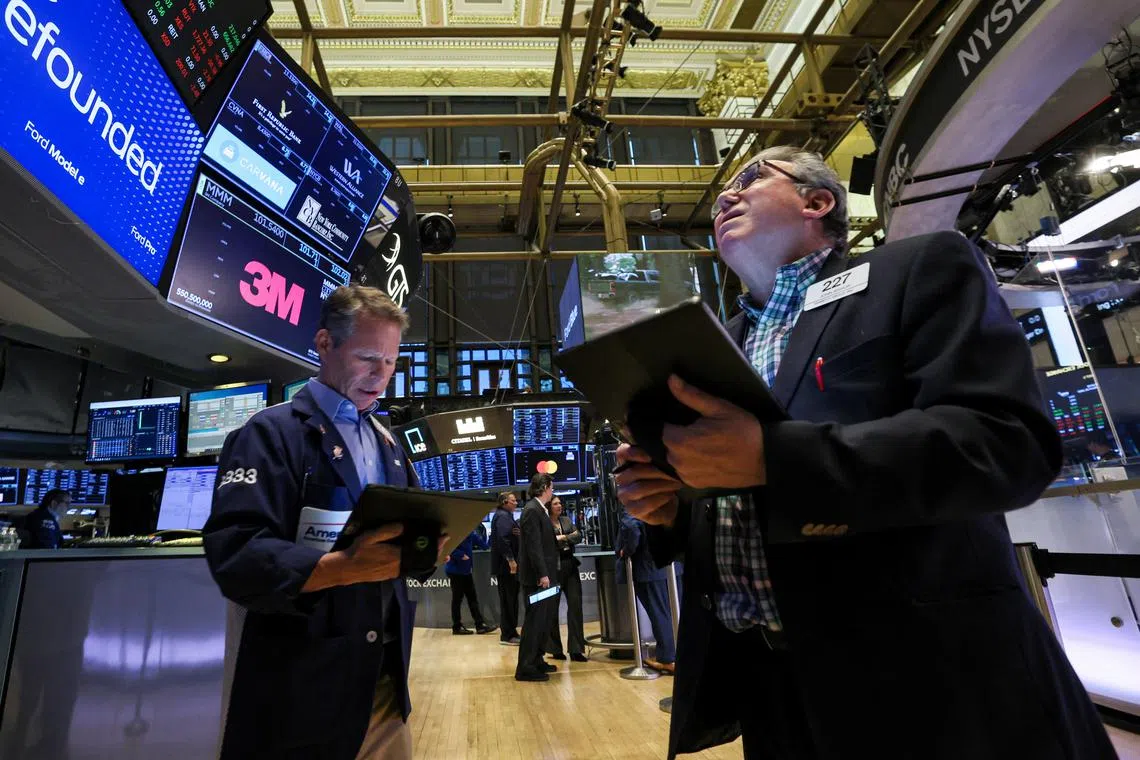Expect market volatility to continue, but also be on the lookout for opportunities
Sign up now: Get ST's newsletters delivered to your inbox

The current volatility presents opportunities for savvy investors with a medium-term investment perspective.
PHOTO: REUTERS
Follow topic:
SINGAPORE - Although markets ended a tumultuous week on a positive note, the fear of contagion in the banking sector
But some market experts believe the current volatility presents opportunities for savvy investors with a medium-term investment perspective, as fear of the unexpected pervades the market.
After three regional banks in the United States were felled by liquidity issues a week ago, contagion spread across to the Atlantic, where the 166-year-old Credit Suisse was brought to its knees and taken over by rival UBS.
On Friday, there were new fears over the health of Germany’s Deutsche Bank, sending its stock plunging by more than 13 per cent in intra-day trading, before it recovered somewhat by the close following assurances by central bankers and influential market experts.
During a week when the US Federal Reserve hiked its key rate by 25 basis points
Meanwhile, the broader S&P 500 ended 1.4 per cent up at 3,970.99 points, while the tech-heavy Nasdaq gained 1.7 per cent for the week to end at 11,823.96 points.
In Singapore, the Straits Times Index finished the week at 3,212.64, up 0.9 per cent and bringing the 2023 year-to-date decline in total return to 0.6 per cent.
Stocks that booked the most net institutional inflow for most of the week included UOB, Genting Singapore, Sembcorp Industries, Sembcorp Marine, Keppel DC real estate investment trust, Top Glove, Thai Beverage, Jardine Cycle & Carriage and Venture Corp.
Going into this week, expect continued volatility as risk assets dance to the tune of more negative news flows, especially as small and mid-sized banks continue to deal with losses from holding US Treasuries.
At the end of 2022, US banks were sitting on US$620 billion (S$826 billion) in unrealised losses, mostly due to rising interest rates.
This is up from just US$8 billion one year earlier.
Meanwhile, Federal Reserve data showed that bank customers collectively pulled US$98.4 billion from accounts for the week ended March 15, as Silicon Valley Bank and Signature Bank failed.
History tells us that such shocks to the banking sector take time to heal, especially since we have not seen a no-holds-barred “shock and awe” response from the US government and central bank.
Treasury Secretary Janet Yellen’s see-sawing on the government’s likely response to deposit insurance was telling.
Although the Fed has hinted that it may pause its rate hike, there is no indication that it will reverse its policy on quantitative tightening.
Higher-for-longer rates remain a reality as Fed chairman Jerome Powell and his colleagues doggedly pursue price stability, which some reckon is now coming at the cost of financial stability.
Oxford Economics, in a note, acknowledged policymakers face a huge challenge to strike the right balance, especially in light of the recent volatility in markets.
“But overall, we think near-term core inflation will prove stickier than the market expects due to the long lags associated with monetary policy,” it noted.
If inflation data in the coming week and months shows stubborn price pressure, the US central bank may be forced to raise rates more than anticipated, and this is not something that the markets are fully ready for, and it could spook investors.
The February US consumer spending inflation data, which is the Fed’s inflation gauge, scheduled for release this Friday, will be closely assessed by the markets.
As investment house Moody’s pointed out in a note last week, as central banks continue to reel in inflation, financial conditions will remain tight, raising the risk that “stresses spread beyond the banking sector, unleashing greater financial and economic damage”.
Mr Vasu Menon, executive director for investment strategy at OCBC Bank, noted that the US banking sector problems further complicate already significant challenges for the Fed, which is trying to deal with inflation and engineer a soft landing.
“The significant unrealised losses, announced by the Federal Deposit Insurance Corporation a few weeks ago, highlights that the US banking system is coming to grips with new strains posed by the Fed’s sharp rate hikes in the past year and there is a risk that rates may surprise on the upside if inflation proves to be stubborn,” he said.
So what is an investor to do?
DBS Bank’s chief investment officer, in the bank’s first quarter for 2023 market outlook report, points to opportunities in a portfolio comprising 60 per cent equities and 40 per cent bonds.
The report expects a slower path of rate increases that will terminate at 5 per cent, as the Fed weighs recession risks.
Inflation is set to slow, but not to the extent where the Fed will begin cutting rates, the report notes.
Meanwhile, Morgan Stanley’s chief US strategist Michael Wilson wrote last week that the stress in the banking system marks what is likely to be the beginning of a painful and “vicious” end to the bear market in US stocks.
“With the back-stopping of bank deposits by the Fed/Federal Deposit Insurance Corporation, many equity investors are asking if this is another form of quantitative easing and therefore ‘risk on’,” wrote Mr Wilson, who correctly predicted the sell-off in stocks in 2022 and rebound in October.
“We argue it’s not, and instead represents the beginning of the end of the bear market as falling credit availability squeezes growth out of the economy.”
This is a surprise, coming from a person who is noted as a long-time Wall Street bear.
So here is the thing.
What we know is that inflation will remain sticky, and interest rates will remain high through 2023.
We also know that while sentiment on the banking front is fragile, central banks are determined to address the problems fully and forcefully. Economic growth is showing signs of slowing.
We also know that China is reopening.
There are more than US$3 trillion in money market funds sloshing around.
And we also know that South-east Asia – seen as an oasis in a geopolitically challenged world – is attracting a lot of funds and investment
That being the case, the strategy for investors should not be to abandon the market entirely. Where there is fear and volatility, there is also opportunity.
Maybank Securities head of research Thilan Wickramasinghe says that while it may be too soon to emerge from defensive positions, investors should be screening for stocks with strong cash flow and fundamentals that are geared towards multi-year cyclical themes.
These include supply chain shifts from North-east Asia, the China reopening, the clean energy transition and accelerating digital network effects from digitalisation.
Sectors geared towards these themes are financials, utilities, construction, energy, supply chain managers and technology manufacturers.
The Singapore market is chock-a-block with these plays.
Do some homework and pick the opportunities, but with a medium-term investment horizon in mind.


